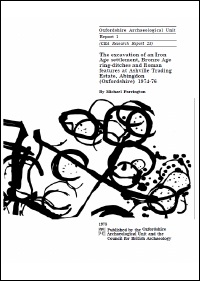CBA Research Reports
Council for British Archaeology, 2000. (updated 2020) https://doi.org/10.5284/1000332. How to cite using this DOI
Data copyright © Council for British Archaeology unless otherwise stated
This work is licensed under the ADS Terms of Use and Access.
Primary contact
Council for British Archaeology
92 Micklegate
York
YO1 6JX
UK
Tel: 01904 671417
Resource identifiers
- ADS Collection: 281
- DOI:https://doi.org/10.5284/1000332
- How to cite using this DOI
The excavation of an Iron Age settlement, Bronze Age ring-ditches and Roman features at Ashville Trading Estate, Abingdon (Oxfordshire) 1974-76
Michael Parrington
CBA Research Report No 28 (1978)
Oxfordshire Archaeological Unit: Report 1
ISBN 0 900312 50 5
Abstract

The excavations revealed a complex of pits, ditches and post-holes, mostly of Iron Age date. These features are interpreted as part of an Iron Age settlement which was replaced in the latter Iron Age by a system of field ditches. Two Roman wells and part of a Roman field system were excavated and a portion of a small Roman cemetery was recorded during a salvage excavation c. 200m. to the south of the site. The Iron Age and Roman occupation of the site was preceded by its use as a funerary area in the Bronze Age, during which time two ring-ditches with associated cremation were located there.
By the use of simple sieving techniques on many of the archaeological features relatively large quantities of carbonized seed remains were recovered which enable fairly accurate assessments of the crop-growing economy of the site to be made. Large amounts of animal bone and Iron Age pottery were also recovered which give indications of the farming practices and ceramic traditions of the site. Other items found during the excavations suggest that weaving and metal working were carried out, and perhaps the most notable object was the remains of a well preserved wooden ard from a 3rd century Roman well. The excavations were carried out by the Oxfordshire Archaeological Unit with the Abingdon and District Archaeological Society in advance of the redevelopment of the area.
Contents
- Title pages
- Preface by Professor B W Cunliffe (p vii)
- Summary (p viii)
- Acknowledgements (p viii)
- Introduction (pp 1-6)
- Geology and topography (p 6)
- The Excavation (pp 6-25)
- General description (p 6)
- Detailed description (p 6)
- Bronze Age (pp 6-11)
- Iron Age Period 1 (p 11)
- Iron Age Period 2 (pp 11-19)
- Iron Age Period 3 (pp 19-22)
- Romano-British period (pp 22-23)
- The Roman cemetery (pp 23-25)
- Post-Roman features (p 25)
- Interpretation (pp 25-40)
- The Bronze Age features by Christopher Balkwill (pp 25-28)
- The ring-ditches and their neighbourhood by Chrsitopher Bulkwill (pp 28-31)
- Bibliography (p 30)
- Appendix 1. A pit with Grooved ware from Abingdon (p 31)
- The Iron Age and Roman features by Michael Parrington (pp 31-40)
- Period 1 (pp 31-34)
- Period 2 (pp 34-36)
- Period 3 (p 36)
- Romano-British period (pp 36-37)
- Animal bones (p 37)
- Domestic industry (p 37)
- The layout of the settlement (p 38)
- The radiocarbon dates and relative chronology of the Iron Age features (p 39)
- Bibliography (p 40)
- The Finds (pp 40-138)
- The Iron Age pottery by C D De Roche (pp 40-74)
- Introduction (p 40)
- Definition of types (pp 41-47)
- Ashville assemblages (p 47)
- Period 1 (pp 47-50)
- Period 2 (pp 50-57)
- Period 3 (pp 57-69)
- Discussion of Ashville ceramics (pp 69-74)
- Bibliography (p 74)
- The Roman pottery by David Miles (pp 74-78)
- Introduction (p 74)
- Samian (pp 74-75)
- Decorated Samian (p 75)
- The coarse pottery (pp 75-78)
- Bibliography (p 78)
- Small finds by Michael Parrington (pp 78-83)
- Bibliography (p 83)
- The Abingdon ard-share by P J Fowler (pp 83-88)
- Bibliography (p 88)
- The quern-stones by Michael Parrington (p 88)
- The slag and crucible fragments by Henry Cleere (pp 88-90)
- The worked flints by W A Skellington (p 90)
- The human remains by Eric Edwards (pp 90-93)
- The molluscan remains by Mark Robinson (p 93)
- The plant remains by Martin Jones (pp 93-110)
- Introduction (pp 93-97)
- Site and laboratory procedures (pp 97-99)
- The data (p 99)
- The statistical manipulation of the data (pp 99-101)
- Review of the botanical information (pp 101-106)
- The deposition of the plant remains (pp 106-108)
- The environment and economy of the site (pp 108-110)
- Bibliography (p 110)
- The animal bones (pp 110-138)
- Summary (p 110)
- Methods and results of bone analysis by Bob Wilson (pp 110-126)
- The sex of cattle horn cores by Philip Armitage (p 126)
- A comparison of the age structure at mortality of some Iron Age and Romano-British sheep and cattle populations by Julie Hamilton (pp 126-133)
- The bird bones by Don Bramwell (p 133)
- General conclusions and discussion of the bone sample by Bob Wilson (pp 133-138)
- Bibliography (pp 138-139)
- The Iron Age pottery by C D De Roche (pp 40-74)
- Plates (pp 140-150)
Download report
| The excavation of an Iron Age settlement, Bronze Age ring-ditches and Roman features at Ashville Trading Estate, Abingdon (Oxfordshire) 1974-76 (CBA Research Report 28) | 7 Mb |







